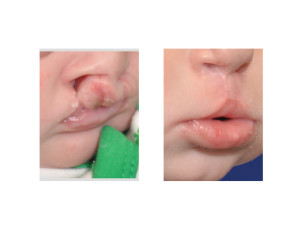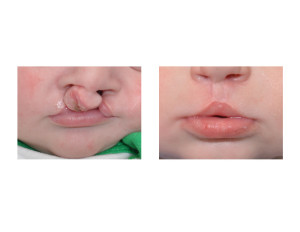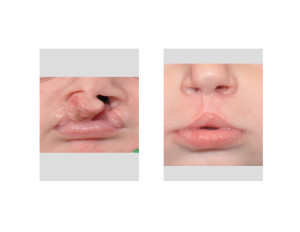Background: Cleft lip and palate is one of the most common facial birth defects often cited as occurring in about 1 in every 1,000 births. While there are race, gender and world wide differences in this occurrence rate, it is a condition that is well recognized around the world for its prevalance. Almost everyone has seen or knows someone who has been affected by some facial cleft problem.
Despite the generic name of cleft lip and palate, it is a collection of orofacial birth defects that has a wide range of variability in how it appears. The cleft can affect one side of the lip, both sides or can cause a cleft palate only. Even in bilateral cleft lip and palate there is great variability. The cleft lip may be complete on both sides, complete on one and incomplete on the other, or incomplete on both sides. This variability in the cleft ip becomes compounded when one factors in the internal cleft palate and alveolar component which can occur variably as well.
Regardless of the type of bilateral cleft lip and palate deformity, the first step in the reconstructive process begins with the bilateral cleft lip repair. While usually done at around 3 to 4 months of age, its timing may be affected by the location of the premaxillary segment beneath the cleft upper lip segment. If it is excessively protrusive and displacing the central upper lip segment far forward, its repositioning by tapes or active appliances (e.g., nasoalveolar molding) may be needed first. Such manuevers put the central lip segment closer to the sides of the lip to avoid extreme tension on the bilateral cleft lip repair after surgery.
Case Study: This infant male was born with a bilateral complete cleft lip and palate deformity. Despite being complete the central lip segment was not projecting too far forward because of the good position of the underlying premaxilla. Taping of the lip segments was done which was adequate for central and lateral lip alignment. Under general anesthesia at 4 1/2 months of age a bilateral cleft lip repair was performed.


Highlights:
1) Bilateral cleft lip and palate is the most severe form of the typical facial cleft birth defects.
2) Reconstruction of the bilateral cleft lip and palate deformity consists of a number of orofacial procedures (often 6 to 8 total) done up to 18 years of age.
3) The first reconstructive surgery in the bilateral cleft patient begins at 4 months of age with an initial bilateral cleft lip repair.
Dr. Barry Eppley
Indianapolis, Indiana



